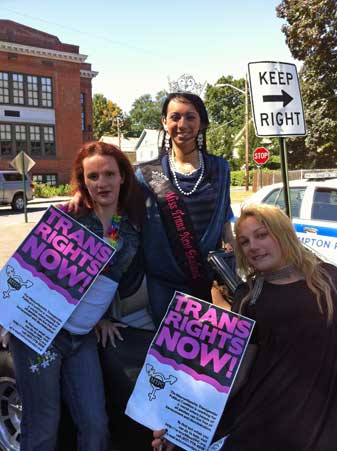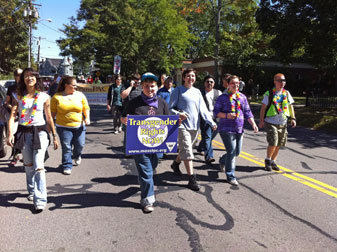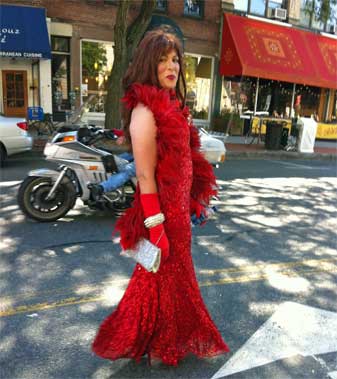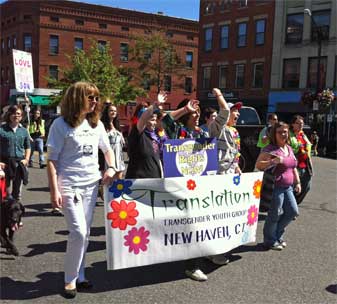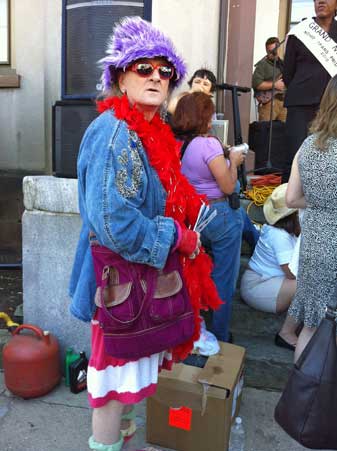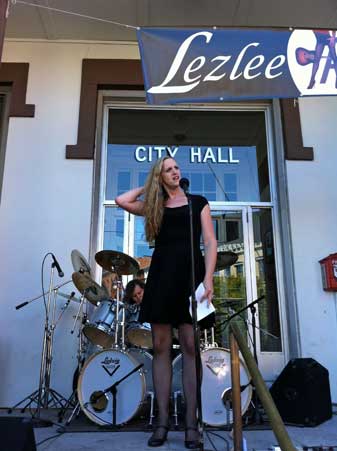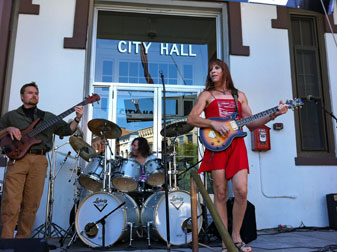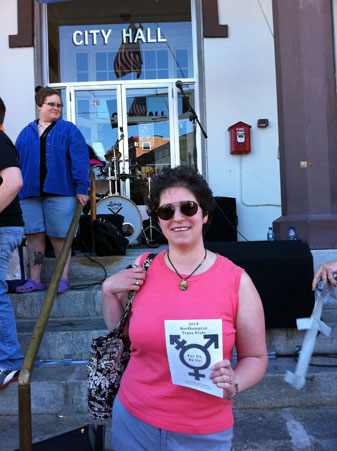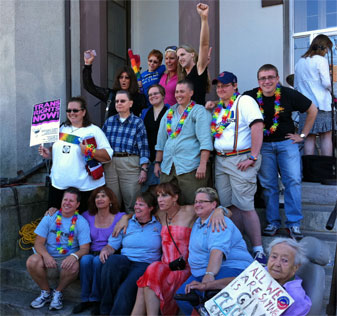Winning Writers subscriber Alvin T. Ethington is not only a published poet, but also the author of this eloquent argument for recognition of same-sex marriage in the Episcopal Church. (I’ll admit, he had me at “The Golden Girls”.) The article first appeared on FanStory.com, a good forum for emerging writers to receive feedback and enter members-only contests. He has kindly permitted me to reprint it below. Alvin tells me, “It proved to be very persuasive in the Diocese of Los Angeles, where same-sex blessings in many parishes now are a matter of course.”
What is a Covenantal Relationship?
by Alvin T. Ethington
On an episode of the television program “The Golden Girls,” Blanche, the woman who owns the house, discovers that she either has to make $10,000 worth of improvements or ask one of the three women who rent from her to move out. The house is not up to code for four people to occupy it. Whilst the women are in the process of discussing what to do, Dorothy comes up with the idea that Blanche can sell to her and the other women a portion of the equity in the house, thereby making the four co-owners. At first, Blanche is appalled by this idea—the house is one in which she lived with her husband, brought up her children, and spent most of her life. It is her family home. Later, when realizing she cannot ask any of her good friends to move out, she discovers her family has changed. Her husband is dead, her children are grown, and the people from whom she seeks support and with whom she lives in community are, indeed, the three other women who share the house. They are her family.
Our definition of family is changing. Adult children move back into the family home for economic reasons; sons and daughters choose to care for their elderly parents at home due to the high cost of medical care. Women have greater freedom in choosing societal roles; gay men and lesbians no longer have to keep the most important relationship of their lives secret. Children whose mother and father both work are often cared for by another relative or a friend; many families choose to adopt because of the large number of unwanted children in the world.
The nuclear family, which was engendered by the industrial revolution and which reached its apex in post-World War II white suburban America, is no longer the primary social unit it was once thought to be. For economic survival, women and men are choosing to live in groups of extended families and/or friends as they have in the past. Within these extended families and within societal communities, bonds of special relationships are being formed. Many people in these relationships of mutuality, love, and respect would like ecclesiastical recognition of what to them is of ultimate importance.
Some would argue that all this is the breakdown of Christian values in a societal context. I do not think so, for the message of Christianity is one of communal responsibility. The early Church provided for widows and orphans (Acts 6:1; cf. James 1:27). Whoever loves and serves Jesus of Nazareth by doing the will of God is his brother or his sister, a part of his family (Mark 3:35, Matthew 12:50).
Examples of covenantal relationships within the Christian community would be an older woman and man who have fallen deeply in love but whose financial situations preclude them marrying because of the concomitant loss of economic benefits that would bring, two lesbians or two gay men who have entered into a lifelong committed relationship, or adoptive parents who want to make a public pledge to bring up their children in the Church. (The Episcopal Church has started to recognize the last example in the 1979 Prayer Book rite “Thanksgiving for the Birth or the Adoption of a Child” which was previously limited to “The Thanksgiving of Women after Child-Birth.”)
Traditionally, the Church has recognized two kinds of covenantal relationships between persons — that of the promise the parents and godparents make to raise children in the faith and instruction of the Church at Baptism, and that of Holy Matrimony. These relationships are definitely sacramental. However, they have been developed and interpreted within the context of a Western society which has accepted the definition of Gratian for marriage — the union of a man and woman for procreation. Given the recognition that marriage has and can fulfill goals other than procreation and given the overpopulation of the world, it is expedient that we look to other definitions for marriage and for covenantal relationships.
The 1661/62 Anglican Prayer Book recognized that, although in its view, marriage is primarily for procreation, it is secondarily a remedy against sin, and tertiarily for mutual society, help, and comfort. Covenantal relationships which include a sexual component fulfill the goal of marriage to avoid fornication and all covenantal relationships fulfill the goal of mutual interdependence.
Is the Church in the process of affirming sexual sin in affirming covenantal relationships? These relationships only include a sexual component when the sex therein is other-concerned, respects the dignity of each person, and recognizes the partners as equals. Just as relationships of forced and non-consensual dominance and submission, of incest, and of rape break the covenant between parent and child or between wife and husband, so relationships which involve abuse of sexuality are not covenantal relationships. Covenantal relationships are inclusive of healthy sexual relationships, but not exclusive to them. Certainly the adoption of a child by a person does not include a sexual component.
Are these relationships sacramental? The Christian Church cannot agree on what exemplifies a Sacrament. If one accepts only the two Dominical Sacraments (Baptism and Holy Eucharist) as Sacraments, then these relationships are not Sacraments, but have a sacramental quality, as does marriage, for they are outward and visible signs of an inward and spiritual grace. If one accepts the seven historical sacraments as Sacraments, then these relationships do not have the Sacramental quality of marriage, but they do have the sacramental quality in which all of life is hallowed. A sacrament takes the simple things of life—water, wine, bread—and invests them with sacred meaning in the context of a person’s and a community’s relationship with God. Covenantal relationships are sacramental in that the two partners have made a commitment to themselves, to each other, to the Christian community, and to God to honor, love, and cherish each other. Because the sacramental quality of covenantal relationships involves two persons made in the image of God and the relationship between them, covenantal relationships are of a higher sacramental order than the blessing of an object. Covenantal relationships have a sacramental quality in that God is ever present in these relationships of love and faithfulness.
The Hebrews recognized this when they reflected on their relationship with God. They imaged their relationship with God in terms of covenantal relationships they knew and imaged their unfaithfulness to God in terms of covenant breaking they knew. God was the Father and Israel was His Son (Hosea 11:1). God was the Mother and Israel Her comforted child (Isaiah 66:13). When Israel was apostate, Israel “played the harlot” (Ezekiel 16:15, 16; cf.16:28); Israel was the unfaithful wife Gomer of the prophet Hosea (Hosea 1:2-3).
Jesus, as pictured in the Gospels, portrays his relationship to different groups in covenantal imagery. In the Q source material, he compares his relationship to the Jewish community of Jerusalem to that of a mother hen to her chicks (Matthew 23:37; Luke 13:34). The Johannine Jesus recognizes the deep bond of friendship between Jesus and his disciples (John 15:14-15).
The love poem Song of Songs has been interpreted to be exemplary of covenantal relationships. It illustrates the love of God for Israel and the love of Christ for the Church. What Jewish and Christian communities have done with this difficult text is to take the relationship between the two lovers and invest it with sacred meaning. God is ever present in the hallowing of special relationships.
Time moves on. The Church is required to be faithful to Scripture and tradition, but it is also open to the influence of reason and to the unfolding revelation of the Holy Spirit within the Church. We must stand in constant tension with and dialogue with society and affirm all persons on their spiritual journeys. We must not be afraid to speak out against sin, but we also must not be reluctant to recognize when God is present. Every good thing comes from God (cf. James 1:17). People are aching for spiritual recognition of their special relationships in a society in which the individual reigns supreme. We, as a Church, must comfort and succor those in this transitory life who daily face adversity. Where two people truly and authentically care about each other, where two people share joy and laughter, love and tears, sorrow and suffering, solace and comfort, life and death, there, indeed, is God.
